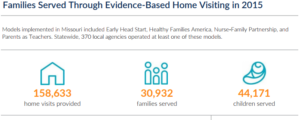Home visiting helps families meet children’s needs during the most critical first years of life. And the results pay off.
The premise of home visiting is simple–pair families who are looking for parenting support with trained professionals, often early childhood specialists, mental health professionals, social workers or nurses.
Home visitors meet with families in their home or wherever it is most comfortable. Depending on the program, families are enrolled anywhere along the continuum from pregnancy through Kindergarten and typically for a period of 24 to 36 months. The home visitors help families build the foundation for the health, education, development, and economic self-sufficiency of the entire family.
Home visitors identify family strengths and parenting skills and then build on them. Depending on the family’s circumstances, home visitors might talk with expectant parents about prenatal care, breastfeeding and what to expect with a newborn. They also may speak with parents about their child’s developmental milestones, coach them in positive parenting, connect them with needed services and even help them create a resume so they can find a job. Most programs provide developmental and other health screenings too.
Some programs are mandated by their funders to be targeted to families in the community who are at the highest risk for poor outcomes, such as teen moms, families in poverty or families in the military. This strategy can help to break generations-long cycles of poverty, addiction, abuse and stress, especially in families who are at the greatest risk. Other funding is less restrictive and allows the program to be offered more universally. Most funders require programs to adhere to a program model’s fidelity and quality requirements—to make sure the program is delivered as intended, so that the community may see demonstrated changes in family and child outcomes.
Home Visiting Programs Support the Healthy Development of Children and Families
There are multiple proven programs offered throughout the United States. For 32 years, Missouri has invested in an evidence-based home visiting program called Parents as Teachers, primarily with general revenue funds flowing through the Department of Elementary and Secondary Education. The program is now the most widely replicated home visiting program in the United States. Nurse Family Partnership, Healthy Families America, and Early Head Start (home based), also evidence-based, nationally implemented models, are supported in Missouri by a mix of state, federal, and private funds. Nurses for Newborns, also founded in Missouri, has been providing services for more than 20 years in the Show-Me State. It also serves residents in Tennessee.

Throughout the country, home visiting is delivered by a variety of organizations, including school districts, health departments, housing authorities, tribal communities, non-profit organizations serving families, religious institutions and health centers. Across the U.S., local communities tend to tailor service delivery based on rigorous needs assessments in order to target families effectively and to meet the needs of the families in their community.
Evidence-based home visiting programs boast significant outcomes. All are designed to improve some combination of the following:
- School readiness and achievement
- Family economic self-sufficiency or family functioning
- Coordination and referral for other community resources
- Maternal and newborn health
- Rates of child injuries, abuse, and neglect
- Rates of crime or intimate partner violence
Over the past decade, home visiting has been expanded in states through state investments. The federal government also currently invests $400M per year in the form of grants to states and tribes to replicate evidence-based home visiting models. The program, referred to as the Maternal, Infant, Early Childhood Home Visiting (MIECHV) program, can be used to expand and improve existing programs, enhance states’ ability to reach vulnerable children, provide infrastructure and administration, improve implementation, support evaluation and create costs savings. The MIECHV program is targeted to families living in poverty and programs adhere to rigorous standards and reporting requirements. Nationally, the program reaches 145,000 vulnerable families.
Missouri’s MIECHV grant is administered by the Department of Health and Senior Services, and currently funds Parents as Teachers, Nurse Family Partnership and Early Head Start programs in the bootheel region of Missouri and St. Louis City. The bootheel has one of the highest rates of poverty in the nation.
Because of its clear evidentiary standards and outcomes, evidence-based home visiting models have provided clarity to philanthropic organizations and local and state governments seeking to leverage investments in proven programs. These philanthropic investments have promoted public/private partnerships and creative financing mechanisms that are promoting expansion of evidence-based home visiting as well as other proven services for children and families. The evidence base for home visiting, including its cost effectiveness, is strong and growing.
To learn more about home visiting visit:


The evidence is clear. What a wide range of significant outcomes for children and their families. If only more decision makers across the US would be bold in choosing to invest in PREVENTION programs like early childhood, home visitation. Pay now or pay a whole lot more later. Thank you for the comprehensive look at what quality programs like Parents as Teachers and others can do and are doing for so many.